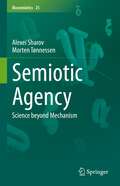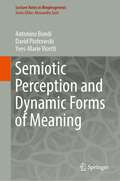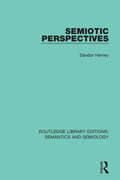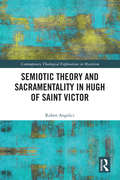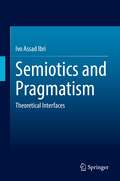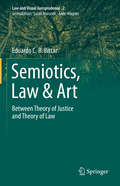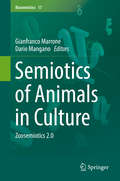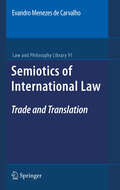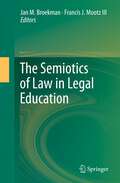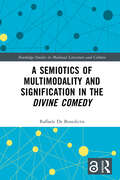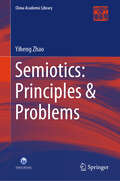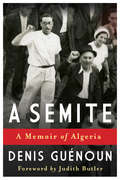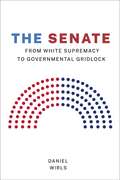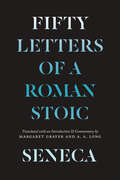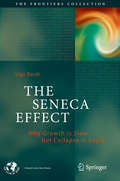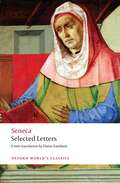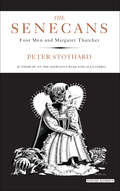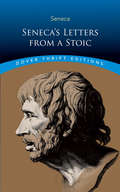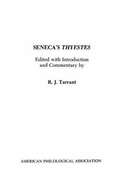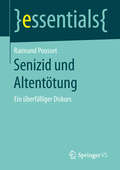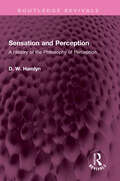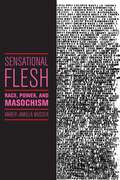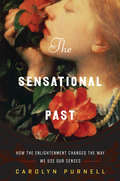- Table View
- List View
Semiotic Agency: Science beyond Mechanism (Biosemiotics #25)
by Alexei Sharov Morten TønnessenThis book invites readers to embark on a journey into the world of agency encompassing humans, other organisms, cells, intracellular molecular agents, colonies, populations, ecological systems, and artificial autonomous systems. We combine mechanistic and non-mechanistic approaches in the analysis of the function and evolution of organisms, their subagents, and multi-organism systems, and in this way offer a theoretical platform for integrating biosemiotics with both natural science and the humanities/social sciences. Agents are autonomous systems that incorporate knowledge on how to make sense of their environment and use it to achieve their goals. The functions of all agents are supported by mechanisms at the lowest level; however, the explanatory power of mechanistic analysis is not sufficient for complex agents. Non-mechanistic methods rely on the goal-directedness of agents whose dynamics follow self-stabilized dynamic attractors. The properties of attractors depend on stable or slowly changing factors, and such dependencies can be interpreted as sign relations if they are adaptive in nature. Agents can replace or redirect mechanisms on demand in order to preserve their functions; for performing higher-level semiotic functions, mechanisms are thus only means. We assume that mechanism and semiosis are not mutually exclusive, and that simple agents can interpret signs mechanistically. This assumption allows us to extend semiotic analysis to all agents, including ribosomes in cells, computers, and robots. This book challenges established traditions in natural science and the humanities/social sciences: semiotics no longer appears as restricted to humans and rational thinking, and biology is no longer limited to rely exclusively on mechanistic reasoning.
Semiotic Perception and Dynamic Forms of Meaning (Lecture Notes in Morphogenesis)
by Antonino Bondi David Piotrowski Yves-Marie VisettiWhat do we mean by semiotic perception? Why should the concepts of perception and expressivity be reinterpreted within the encompassing framework of a dynamic theory of semiotic fields and forms? Can we redeploy the concept of form in such a way as to make explicit such a native solidarity (‘chiasmatic’ would have said Merleau-Ponty) between perception, praxis and expression -- and first and foremost in the activity of language, right to the heart of the life of the social and speaking animal that we are? What then would be the epistemological and ontological consequences, and how might this affect the way we describe semiolinguistic forms? This book aims to provide answers to these questions by opening up avenues of research on how to understand the linguistic and semiotic dimensions at work in the constitution of experience, both individual and collective.
Semiotic Perspectives (Routledge Library Editions: Semantics and Semiology)
by Sándor HerveyFirst published in 1982, this book looks at a wide variety of issues concerning the vast field of study that is ‘semiotics. It begins by tracing the beginnings of modern semiotics in the works two pioneering figures — Saussure and Peirce — in order to present fundamental assumptions, notions and distinctions which provide an essential background to the more recent developments. The author then goes on to look at Behavioural Semiotics, Luis Prieto’s idea of "l’Acte Semique", Austin’s theory of ‘Speech Acts’ and Searle’s elaborations, Barthes’ move away from philosophical and scientific approaches in his ideology of Socio-Cultural Signification, Functionalism and Axiomatic Functionalism, style as a form of communication, semiotics of the cinema, and communicative behaviour in non-human species.
Semiotic Theory and Sacramentality in Hugh of Saint Victor (Contemporary Theological Explorations in Mysticism)
by Ruben AngeliciThis book offers Hugh of Saint Victor’s early scholastic thoughts on sacrament in order to re-discover the pre-modern theological understanding of ontological signification. The Christian understanding of sacrament through the category of ‘signs’ results in a theology that inherently shares in the philosophical notion of semiotics. Yet, through the advent of post-structuralism, current sign-theory is effectively shaped by post-Kantian, ontological foundations. This can lead to misinterpretations of the sacramental theology that predates this intellectual turn. The book works within a context of Christological, realist mysticism. Such an approach allows mutually informing debates in semiotic development and studies on sacramental theology to sit side-by-side. In addition, as a work of ressourcement, influenced by the methodology and concerns of the historical, French Ressourcement, this study seeks to continue an engagement with some of the most promising sacramental positions that have emerged throughout twentieth-century theology, particularly with the revival of interest in Victorine theology. By providing an examination of sacramentality and theories of signification in the early scholastic theology of Hugh of Saint Victor, this book gives fresh impetus to the theology surrounding sacrament. As such, it will be of great interest to scholars of mysticism, theologians of sacrament, philosophical theologians, and philosophers of religion.
Semiotics and Pragmatism: Theoretical Interfaces
by Ivo Assad IbriThis collection of essays brings together a selection of some of the most important studies of Professor Ivo Assad Ibri about the work of Charles Sanders Peirce. In the last decades, Prof. Ibri made important contributions to Peirce studies by showing that the various individual aspects of Peirce’s work actually form a coherent philosophical system, a metaphysical architecture, as he describes it in his previous book Kósmos Noetós (Springer, 2017). Now this new book brings together a selection of 24 articles and book chapters originally published in both Portuguese and English on different topics and aspects of Peirce’s work, such as philosophy of art, heuristic logic, theories of beliefs and habits, objective idealism, pragmatism and pragmaticism. By bringing together this collection of essays in a single publication, Semiotics and Pragmatism: Theoretical Interfaces will be a valuable source for scholars interested in Prof. Ibri’s unique contributions to the study of the philosophy of Charles Sanders Peirce. “In recognizing Ivo Assad Ibri as one the leading exponents of qualitative interpretations of Peirce in the world today, I refer especially to Ibri’s concentration on Peirce’s later-phase metaphysical writings. Ibri’s expertise will be seen to consist in his precise reformulations of Peirce’s full-fledged philosophy, not just pursuing specialized minor topics.” David A. Dilworth Professor of Philosophy, Stonybrook University “Ivo Ibri’s collected essays brims with clarifying insights from beginning to end. He manages to reveal plenty of aspects of Peirce’s thought from angles the traditional scholarship has not been equipped to notice. How not to miss such kairotic theoretical opportunities and how to exploit them to heuristic advantage is a lesson well taught in this outstanding book.” André De Tienne Professor of Philosophy and Director of the Peirce Edition Project, Indiana University
Semiotics, Law & Art: Between Theory of Justice and Theory of Law (Law and Visual Jurisprudence #2)
by Eduardo C.B. BittarThis book presents an interdisciplinary study of the relation between semiotics, law & art. Focusing on Greimasian semiotics, it examines specific works of art (from Giotto to Banksy) that deal with the theme of justice, promoting a more sensitive and humanized perception of the values that surround law. The book offers readers a comprehensive review of the semiotics of law, critically examining the relation between law & art. It covers a variety of topics, including semiotics, law and art; semiotics, art and experience; and society, law and art, as well as semiotics, law and painting; semiotics, law and architecture; semiotics, law and theatre; semiotics, law and literature; and semiotics, law and culture. In doing so, it uses the semiotics of painting to explain the symbology of justice and its significance in history; the semiotics of architecture to explain the setting of justice; the semiotics of theatre to explain the logic of the legal process; and the semiotics of literature to explain the narrative logic of legal decisions. Lastly, drawing on the semiotics of culture, it discusses ways of promoting justice, citizenship and human rights. Written from both philosophical and semiotical perspectives, the book enhances the centrality of visual jurisprudence studies to promote a better understanding of the role of law.
Semiotics of Animals in Culture: Zoosemiotics 2. 0 (Biosemiotics Ser. #17)
by Gianfranco Marrone Dario ManganoTo place animals within the realm of nature, means inserting them among the articulations of culture and the social. Semiotics has never avoided this chiasmus, choosing to deal from the outset with the problem of the languages of animals following the old admonition of Montaigne: it is not that animals do not talk, it is us who do not understand them.Recent research in the field of the anthropology of nature and sociology of sciences and techniques allow to think about the Zoosemiotic issue in a different way. Instead of transplanting the language structures – gestures, LIS, etc. – for a semiotic study of the forms of the human and social meaning, it seems more apt to look at their discourse, and as such, the actual interactions, communicative and scientific as well as practical and functional, between humans and non-humans. This book aims to investigate precisely this hypothesis, known here as Zoosemiotics 2.0, working on several fronts and levels:· Anthropology· Languages of the image and visual representations, from art history to cinema· Old and new media. From literature to comics, from cartoons to TV documentaries but also advertising, music, Web and social networks. All those cultural products that talk about the role of human and non-human in society implicitly proposing (and in some way imposing) a form of articulation of such a relationship.· Food and feeding rites· Animalist, vegetarian and vegan movements · Philosophy: metaphysics, ethics, aesthetics
Semiotics of International Law
by Evandro Menezes de CarvalhoLanguage carries more than meanings; language conveys a means of conceiving the world. In this sense, national legal systems expressed through national languages organize the Law based on their own understanding of reality. International Law becomes, in this context, the meeting point where different legal cultures and different views of world intersect. The diversity of languages and legal systems can enrich the possibilities of understanding and developing international law, but it can also represent an instability and unsafety factor to the international scenario. This multilegal-system and multilingual scenario adds to the complexity of international law and poses new challenges. One of them is legal translation, which is a field of knowledge and professional skill that has not been the subject of theoretical thinking on the part of legal scholars. How to negotiate, draft or interpret an international treaty that mirrors what the parties, - who belong to different legal cultures and who, on many occasions, speak different mother tongues - ,want or wanted to say? By analyzing the decision-making process and the legal discourse adopted by the WTO's Appellate Body, this book highlights the active role of language in diplomatic negotiations and in interpreting international law. In addition, it also shows that the debate on the effectiveness and legitimacy of International Law cannot be separated from the linguistic issue.
The Semiotics of Law in Legal Education
by Jan M. Broekman Francis J. Mootz IIIThis book offers educational experiences, including reflections and the resulting essays, from the Roberta Kevelson Seminar on Law and Semiotics held during 2008 - 2011 at Penn State University's Dickinson School of Law. The texts address educational aspects of law that require attention and that also are issues in traditional jurisprudence and legal theory. The book introduces education in legal semiotics as it evolves in a legal curriculum. Specific semiotic concepts, such as "sign", "symbol" or "legal language," demonstrate how a lawyer's professionally important tasks of name-giving and meaning-giving are seldom completely understood by lawyers or laypeople. These concepts require analyses of considerable depth to understand the expressiveness of these legal names and meanings, and to understand how lawyers can "say the law," or urge such a saying correctly and effectively in the context of a natural language that is understandable to all of us. The book brings together the structure of the Seminar, its foundational philosophical problems, the specifics of legal history, and the semiotics of the legal system with specific themes such as gender, family law, and business law.
A Semiotics of Multimodality and Signification in the Divine Comedy (Routledge Studies In Medieval Literature And Culture Ser.)
by Raffaele De BenedictisA new critical method for the Divine Comedy which focuses not only on language-as-writing but also and equally on other discursive modes that the Divine Comedy authorizes. Multimodality was already present in Dante’s time, and the reception of the Divine Comedy took place multimodally. Thus, a theoretical study of multimodality carried out under the semiotic lens sheds light on how and why a mode is more effective than another and/or how they may combine in producing signification and new ontologies warranted by Dante’s text. Also, we do not yet have a critical theory that allows us to understand the function of multimodality for the creation of new forms of signification and of clarifying the ontological boundaries set forth by different modalities. It is a new and original study which contributes to the advancement of Dante Studies, Literary Criticism (with a focus on literary semiotics), Multimedia/Multiliteracy, philosophy of language, communication, and education. Chapters 1, 2, and 5 of this book are freely available as a downloadable Open Access PDF at http://www.taylorfrancis.com under a Creative Commons Attribution-Non Commercial-No Derivatives (CC-BY-NC-ND) 4.0 license. .
Semiotics: Principles & Problems (China Academic Library)
by Yiheng ZhaoThis book attempts to build semiotics on a new foundation, which is “meaning-making”. At the very beginning, the central terms of signs and semiotics are redefined, as the old definition for sign (one thing standing for another) is far from satisfactory. Sign is a perception that is regarded as carrying meaning. In this way, semiotics, now built on the foundation of meaning-making and meaning-cognition, is a science of meaning. All the principles are now under the scrutiny of the new definition, and many issues are answered more succinctly. Therefore, the new definition is extended to the new fields of cultural activities in human society, and a series of problems arise. This book intends to discuss and explore these questions, such as the “middle reclining” in the cultural markedness, the sliding of motivation in art, the difficult distinction between falsehood and untruthfulness, and the driving force of modernization in China.
A Semite: A Memoir of Algeria
by Denis GuenounIn this vivid memoir, Denis Guénoun excavates his family's past and progressively fills out a portrait of an imposing, enigmatic father. René Guénoun was a teacher and a pioneer, and his secret support for Algerian independence was just one of the many things he did not discuss with his teenaged son. To be Algerian, pro-independence, a French citizen, a Jew, and a Communist were not, to René's mind, dissonant allegiances. He believed Jews and Arabs were bound by an authentic fraternity and could only realize a free future together. René Guénoun called himself a Semite, a word that he felt united Jewish and Arab worlds and best reflected a shared origin. He also believed that Algerians had the same political rights as Frenchmen. Although his Jewish family was rooted in Algeria, he inherited French citizenship and revered the principles of the French Revolution. He taught science in a French lycée in Oran and belonged to the French Communist Party. His steadfast belief in liberty, equality, and fraternity led him into trouble, including prison and exile, yet his failures as an activist never shook his faith in a rational, generous future.René Guénoun was drafted to defend Vichy France's colonies in the Middle East during World War II. At the same time, Vichy barred him and his wife from teaching because they were Jewish. When the British conquered Syria, he was sent home to Oran, and in 1943, after the Allies captured Algeria, he joined the Free French Army and fought in Europe. After the war, both parents did their best to reconcile militant unionism and clandestine party activity with the demands of work and family. The Guénouns had little interest in Israel and considered themselves at home in Algeria; yet because he supported Algerian independence, René Guénoun outraged his French neighbors and was expelled from Algeria by the French paramilitary Organisation Armée Secrète. He spent his final years in Marseille. Gracefully weaving together youthful memories with research into his father's life and times, Denis Guénoun re-creates an Algerian past that proved lovely, intellectually provocative, and dangerous.
The Senate: From White Supremacy to Governmental Gridlock (Constitutionalism and Democracy)
by Daniel WirlsIn this lively analysis, Daniel Wirls examines the Senate in relation to our other institutions of government and the constitutional system as a whole, exposing the role of the "world’s greatest deliberative body" in undermining effective government and maintaining white supremacy in America.As Wirls argues, from the founding era onward, the Senate constructed for itself an exceptional role in the American system of government that has no firm basis in the Constitution. This self-proclaimed exceptional status is part and parcel of the Senate’s problematic role in the governmental process over the past two centuries, a role shaped primarily by the combination of equal representation among states and the filibuster, which set up the Senate’s clash with modern democracy and effective government and has contributed to the contemporary underrepresentation of minority members. As he explains, the Senate’s architecture, self-conception, and resulting behavior distort rather than complement democratic governance and explain the current gridlock in Washington, D.C. If constitutional changes to our institutions are necessary for better governance, then how should the Senate be altered to be part of the solution rather than part of the problem? This book provides one answer.
Seneca: Moral and Political Essays
by John M. Cooper J. F. Procopé Lucius Annaeus SenecaThis volume offers new translations of the most important of Seneca's "Moral Essays": On Anger, On Mercy, On the Private Life, and the first four books of On Favours. They give a full picture of the social and moral outlook of an ancient Stoic thinker. A General Introduction describes Seneca's life and career and explains the fundamental ideas underlying the Stoic moral, social and political philosophy in the essays. Individual introductions, footnotes and biographical notes explain their historical and philosophical contexts.
Seneca: Fifty Letters of a Roman Stoic
by Lucius Annaeus SenencaA selection of Seneca’s most significant letters that illuminate his philosophical and personal life. “There is only one course of action that can make you happy. . . . rejoice in what is yours. What is it that is yours? Yourself; the best part of you.” In the year 62, citing health issues, the Roman philosopher Seneca withdrew from public service and devoted his time to writing. His letters from this period offer a window onto his experience as a landowner, a traveler, and a man coping with the onset of old age. They share his ideas on everything from the treatment of enslaved people to the perils of seafaring, and they provide lucid explanations for many key points of Stoic philosophy. This selection of fifty letters brings out the essentials of Seneca’s thought, with much that speaks directly to the modern reader. Above all, they explore the inner life of the individual who proceeds through philosophical inquiry from a state of emotional turmoil to true friendship, self-determination, and personal excellence.
The Seneca Effect
by Ugo BardiThe essence of this book can be found in a line written by the ancient Roman Stoic Philosopher Lucius Annaeus Seneca: "Fortune is of sluggish growth, but ruin is rapid". This sentence summarizes the features of the phenomenon that we call "collapse," which is typically sudden and often unexpected, like the proverbial "house of cards. " But why are such collapses so common, and what generates them? Several books have been published on the subject, including the well known "Collapse" by Jared Diamond (2005), "The collapse of complex societies" by Joseph Tainter (1998) and "The Tipping Point," by Malcom Gladwell (2000). Why The Seneca Effect? This book is an ambitious attempt to pull these various strands together by describing collapse from a multi-disciplinary viewpoint. The reader will discover how collapse is a collective phenomenon that occurs in what we call today "complex systems," with a special emphasis on system dynamics and the concept of "feedback. " From this foundation, Bardi applies the theory to real-world systems, from the mechanics of fracture and the collapse of large structures to financial collapses, famines and population collapses, the fall of entire civilzations, and the most dreadful collapse we can imagine: that of the planetary ecosystem generated by overexploitation and climate change. The final objective of the book is to describe a conclusion that the ancient stoic philosophers had already discovered long ago, but that modern system science has rediscovered today. If you want to avoid collapse you need to embrace change, not fight it. Neither a book about doom and gloom nor a cornucopianist's dream, The Seneca Effect goes to the heart of the challenges that we are facing today, helping us to manage our future rather than be managed by it.
Seneca Selected Letters (Oxford World's Classics)
by Seneca Corporation Staff Elaine FanthamWe often speak of Seneca as the most distinguished of the many Spanish writers and poets of Rome's imperial age, starting from his own father of the same name, and his nephew Lucan, and including Columella, Martial, and Quintilian. But although all of these writers came from Spain, they were Roman (or Italian) in descent, culture, and tradition. Scipio Africanus had taken eastern and southern Spain from the Carthaginians during the Hannibalic war, and most of the Spanish peninsula had been Roman since the second century BCE.
The Senecans: Four Men and Margaret Thatcher
by Peter Stothard“This unconventional account of the Margaret Thatcher years by a former editor of the Times . . . mixes reminiscence, gossip, and classical philosophy.” —The New YorkerA year after the death of Margaret Thatcher, a young historian arrives to ask Peter Stothard, Editor of the Times Literary Supplement and former editor of the Times, some sharp questions about his memories of the Thatcher era. During the interview the offices from where he long observed British politics are being systematically flattened by wrecking balls. From the dust and destruction of a collapsing newspaper plant emerge portraits of the Senecans, four of the men who made the Thatcher court so different from that of her successors. As well as love of Britain’s first female Prime Minister they shared strange Latin lessons in a crumbling riverside bar. They took their name from their taste for the work of Lucius Annaeus Seneca, a pioneer writer from Cordoba in Roman Spain, a philosopher, courtier and acquirer of massive wealth from the age of the Emperor Nero. Blending memoir with ancient and modern politics in the manner of his acclaimed diaries, Spartacus Road and Alexandria, Peter Stothard sheds a sideways light on Margaret Thatcher’s “believing age.” In finally identifying his interviewer he also answers questions about his own literary and political journey.“[An] artful blend of truth and fiction . . . Stothard’s poetically written, supremely stylish memoir only partly conceals its underlying mission, to insist that antiquity still has urgent things to tell us.” —Emily Gowers, The Guardian“This thoughtful and unexpectedly moving memoir . . . brilliantly captures the excitement of the Thatcher years.” —Richard Aldous, The Wall Street Journal
Seneca's Letters from a Stoic
by Lucius Annaeus Seneca Richard Mott GummereAs chief advisor to the emperor Nero, Lucius Annaeus Seneca was most influential in ancient Rome as a power behind the throne. His lasting fame derives from his writings on Stoic ideology, in which philosophy is a practical form of self-improvement rather than a matter of argument or wordplay. Seneca's letters to a young friend advise action rather than reflection, addressing the issues that confront every generation: how to achieve a good life; how to avoid corruption and self-indulgence; and how to live without fear of death. Written in an intimate, conversational style, the letters reflect the traditional Stoic focus on living in accordance with nature and accepting the world on its own terms. The philosopher emphasizes the Roman values of courage, self-control, and rationality, yet he remains remarkably modern in his tolerant and cosmopolitan attitude. Rich in epigrammatic wit, Seneca's interpretation of Stoicism constitutes a timeless and inspiring declaration of the dignity of the individual mind.
Seneca's Thyestes
by Lucius Annaeus Seneca R. J. TarrantThyestes is widely acknowledged to be one of Seneca's most powerful tragedies. The book provides a modern commentary on the play.
Senicide and Old Age Killing: An Overdue Discourse (essentials)
by Raimund PoussetRaimund Pousset gives in this essential a concise account of senicide, the modern form of cultural killing of the elderly. He sheds light on both the history and the current situation of an ancient method. Practiced for millennia almost everywhere in the world, this custom of actively disposing of old 'useless' people or passively putting oneself to death is increasingly being revived today. Senicide is a nameless and silent scandal in our modern, enlightened society. The author wishes to bring this silent death into the focus of a mindful professional public, for the segregation of old age and the avalanche of costs in health care suggest that senicide will continue to grow in sad significance
Senizid und Altentötung: Ein überfälliger Diskurs (essentials)
by Raimund PoussetRaimund Pousset gibt in diesem essential eine knappe Darstellung des Senizids, die moderne Form der kulturellen Altentötung. Er beleuchtet sowohl die Geschichte als auch die aktuelle Situation einer uralten Methode. Diese seit Jahrtausenden fast überall auf der Welt praktizierte Sitte, alte ‚nutzlose‘ Menschen aktiv zu beseitigen oder sich passiv selbst zu Tode zu befördern, wird heute zunehmend wiederbelebt. Der Senizid ist in unserer modernen, aufgeklärten Gesellschaft ein namenloser und stiller Skandal. Der Autor möchte diesen stillen Tod in den Fokus einer achtsamen Fachöffentlichkeit stellen, denn die Segregation des Alters und die Kostenlawine im Gesundheitswesen lassen vermuten, dass der Senizid weiter an trauriger Bedeutung gewinnen wird.
Sensation and Perception: A History of the Philosophy of Perception (Routledge Revivals)
by D. W. HamlynFirst published in 1961, Sensation and Perception aims to cast light upon the nature of perception itself. This, the author believes, can be achieved only through an understanding of the concepts of sensation and perception. A survey of the principal attempts to arrive at such an understanding brings out the fact that perception has most often been assimilated to sensation or judgment. The author believes that both of these views are wrong but that an attention to the history of thought can provide an explanation of the temptation to accept them. A final chapter gives the author’s own views on the nature of sensation and perception. As such it would be of interest both to philosophers and to those psychologists who are concerned with the nature of perception.
Sensational Flesh: Race, Power, and Masochism (Secular Studies #43)
by Amber Jamilla MusserThis &“lively and enlightening contribution to queer studies&” investigates power, race, and gender through the lens of masochism (Darieck Scott, author of Extravagant Abjection). In everyday language, masochism is usually understood as the desire to abdicate control in exchange for sensation—pleasure, pain, or a combination thereof. Yet at its core, masochism is a site where power, bodies, and society come together. Drawing on rich and varied sources—from nineteenth century sexology, psychoanalysis, and critical theory to literary texts and performance art—Amber Jamilla Musser employs masochism as a diagnostic tool for probing relationships between power and subjectivity. Engaging with a range of debates about lesbian S&M, racialization, femininity, and disability, as well as key texts such as Sacher-Masoch&’s Venus in Furs, Pauline Réage&’s The Story of O, and Michel Foucault's History of Sexuality, Musser renders legible the complex ways that masochism has been taken up by queer, feminist, and critical race theories. Furthering queer theory&’s investment in affect and materiality, she proposes &“sensation&” as an analytical tool for illustrating what it feels like to be embedded in structures of domination such as patriarchy, colonialism, and racism—as well as what it means to embody femininity, blackness, and pain. Sensational Flesh is ultimately about how difference is made material through race, gender, and sexuality and how that materiality is experienced.
The Sensational Past: How the Enlightenment Changed the Way We Use Our Senses
by Carolyn PurnellSight, smell, hearing, taste, and touch—as they were celebrated during the Enlightenment and as they are perceived today. Blindfolding children from birth? Playing a piano made of live cats? Using tobacco to cure drowning? Wearing “flea”-colored clothes? These actions may seem odd to us, but in the eighteenth century, they made perfect sense. As often as we use our senses, we rarely stop to think about their place in history. But perception is not dependent on the body alone. Carolyn Purnell persuasively shows that, while our bodies may not change dramatically, the way we think about the senses and put them to use has been rather different over the ages. Journeying through the past three hundred years, Purnell explores how people used their senses in ways that might shock us now. And perhaps more surprisingly, she shows how many of our own ways of life are a legacy of this earlier time. The Sensational Past focuses on the ways in which small, peculiar, and seemingly unimportant facts open up new ways of thinking about the past. You will explore the sensory worlds of the Enlightenment, learning how people in the past used their senses, understood their bodies, and experienced the rapidly shifting world around them. In this smart and witty work, Purnell reminds us of the value of daily life and the power of the smallest aspects of existence using culinary history, fashion, medicine, music, and many other aspects of Enlightenment life.
